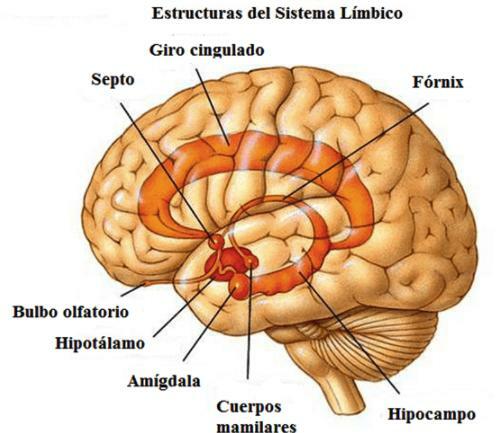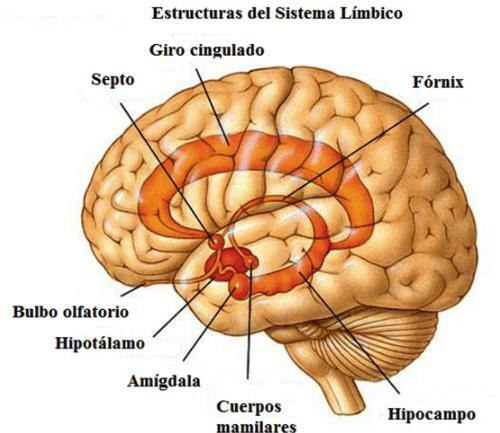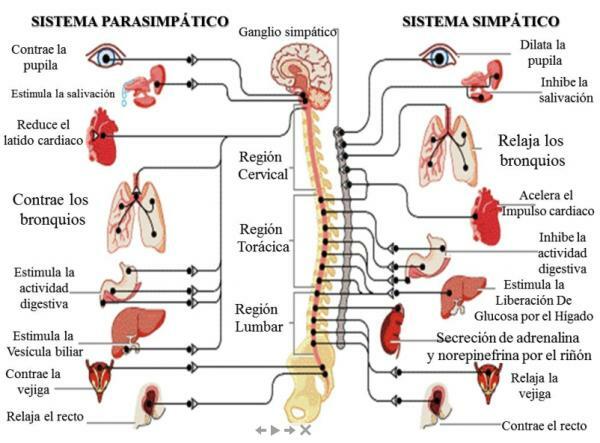For Dr. George Boeree. March 20, 2018

Emotion implies the nervous system completely. But there are two parts of the nervous system that are especially important: The limbic system and the autonomic nervous system. The autonomic nervous systemTogether with the hypothalamus, it regulates the pulse, blood pressure, respiration, and arousal in response to emotional signals. When activated, the sympathetic nervous system prepares the body for emergency actions by controlling the glands of the endocrine system.
The limbic system is a complex set of structures found above and around the thalamus, and just below the cortex. It includes the hypothalamus, hippocampus, amygdala, and many other nearby areas. It seems to be the main person in charge of our emotional life, and it has a lot to do with the formation of memories.
Hypothalamus
The hypothalamus is a small part of the brain located just below the thalamus on either side of the third ventricle. (The ventricles are areas within the cortex that are filled with cerebrospinal fluid, and connected to spinal fluid.) It is situated within the two tracts of the optic nerve, and just above (and intimately connected to) the pituitary gland.
The hypothalamus is one of the busiest parts of the brain, and is primarily related to the homeostasis . Homeostasis is the process of returning something to some "set point". It works like a thermostat: when your room is too cold, the thermostat transports that information to the heater and turns it on. The moment your room heats up and the temperature reaches beyond a certain point, it sends a signal that tells the heater to turn off.
The hypothalamus is responsible for regulating your hunger, thirst, pain response, levels of pleasure, sexual satisfaction, anger and aggressive behavior, and more. It also regulates the functioning of the sympathetic and parasympathetic nervous systems, which means it regulates things. such as pulse, blood pressure, respiration, and physiological activation in response to circumstances emotional
The hypothalamus receives inputs from various sources. From the vagus nerve, it acquires information about blood pressure and gut distention (that is, how full is your stomach). From the reticular formation in the brainstem, you get information about the temperature of the skin. From the optic nerve, it receives information about light and dark. From unusual neurons that line the centricles, it receives information about the contents of the cerebrospinal fluid, including the toxins that lead to vomiting. And from other parts of the limbic system and the olfactory (smell) nerves, information is received that helps regulate food and sexuality. The hypothalamus also has some receptors of its own, which provide it with information about the ion balance and temperature of the blood.
According to one of the most recent discoveries, there appears to be a protein called leptin that is released by fat cells when we eat too much. The hypothalamus apparently senses the levels of leptin in the bloodstream and responds with a decrease in appetite. It might appear that some people have a genetic mutation in a gene that makes leptin, and their bodies cannot tell the hypothalamus that they have had enough. However, many overweight people do not have this mutation, so there is still a lot of research to do!
The hypothalamus sends instructions to the rest of the body in two ways. The first one is towards the autonomic nervous system . This allows the hypothalamus to have ultimate control of things like blood pressure, heart rate, respiration, digestion, sweating, and all sympathetic and parasympathetic functions.
The other way the hypothalamus controls things is through pituitary gland . It is neurologically and chemically connected to the pituitary, which alternately pumps hormones called release factors into the bloodstream. As you know, the pituitary is called the "master gland", and these hormones are of vital importance in regulating growth and metabolism.
The Hippocampus
The hippocampus consists of two "horns" that describe a curve from the area of the hypothalamus to the amygdala. It seems to be very important in turning the things that are "on your mind" now (in short-term memory) into things that you will remember for a long time (long-term memory). If the hippocampus is damaged, a person cannot build new memories, and lives in a strange place where everything that experience simply fades away, even while the oldest memories before the damage remain! intact! This unfortunate situation is quite well described in the wonderful movie. Memento.
Amygdala
The amygdala is a mass shaped like two almonds that sit on either side of the thalamus at the lower end of the hippocampus. When electrically stimulated, animals respond with aggression. And if the amygdala is removed, the animals become very docile and no longer respond to things that previously would have caused them rabies. But there is more to it than just anger: When removed, animals also become indifferent to stimuli that might otherwise have caused fear and even sexual responses.

Beneath the hypothalamus, hippocampus, and amygdala, there are other areas in the structures near the limbic system that are intimately connected to it:
The cingulate gyrus It is the part of the cortex located near the limbic system. It provides a pathway from the thalamus to the hippocampus, and appears to be responsible for the association of memories with odors and pain.
The septal area , which lies in front of the thalamus, has some neurons that appear to be orgasm centers (one for boys, four for girls).
The ventral tegmental area of the brainstem (just below the thalamus) consists of dopamine pathways that appear to be responsible for pleasure. People with damage in this place tend to have a hard time getting pleasure in life, and they often indulge in alcohol, drugs, candy, and gambling.
The prefrontal cortex , which is the part of the frontal lobe that is in front of the motor area, is also closely linked to the limbic system. Besides apparently being involved in thinking about the future, making plans, and taking actions, it also seems be involved in the same dopamine pathways as the ventral tegmental area, and plays a role in pleasure and addiction.
The second part of the nervous system that has a particularly powerful role to play in our emotional lives is the autonomic nervous system. The autonomic nervous system is made up of two parts, which function mainly in opposition to each other. The first one is the sympathetic nervous system, which begins in the spinal cord and travels to a wide variety of areas of the body. Its function appears to be to prepare the body for the kinds of vigorous activities associated with flight or fight, that is, with flight from danger or with preparation for violence.
Activation of the sympathetic nervous system has the following effects:
- Dilate the pupils
- Open your eyelids
- stimulates the sweat glands
- dilates blood vessels in large muscles
- constricts blood vessels in the rest of the body
- increases heart rate
- opens the bronchial tubes of the lungs
- inhibits secretions in the digestive system
One of its most important effects is causing the adrenal glands to release epinephrine (aka adrenaline) into the bloodstream. Epinephrine is a powerful hormone that causes various parts of the body to respond in the same way as the sympathetic nervous system. Once in the bloodstream, it takes a while for its effects to stop. This is why, when you are angry, sometimes it takes a little while before you calm down again!
The sympathetic nervous system also carries information, most of it concerning pain in internal organs. Because the nerves that carry information about pain from the organs often travel through the The same pathways that carry pain information from more superficial areas of the body, information is sometimes confuses. This is called referred pain, and the best known example is the pain that some people feel in the shoulders and arms when they are having a heart attack.
The other part of the autonomic nervous system is called parasympathetic nervous system . It has its roots in the brain stem and spinal cord of the lower back. Its function is to bring the body back from the emergency situation to which the sympathetic nervous system led it.
Some details of the activation of parasympathetic activation include ...
- pupillary constriction
- activation of the salivary glands
- stimulation of stomach secretions
- stimulation of the activity of the intestines
- stimulation of secretions in the lungs
- constriction of the bronchial tubes
- decreased heart rate
The parasympathetic nervous system also has some sensory capabilities: it receives information about blood pressure, carbon dioxide levels, and so on.
There is actually one more part of the autonomic nervous system that we don't mention very often: The enteric nervous system. This is a complex of nerves that regulate the activity of the stomach. When you get sick to your stomach or get butterflies when you're nervous, you can blame the enteric nervous system.



